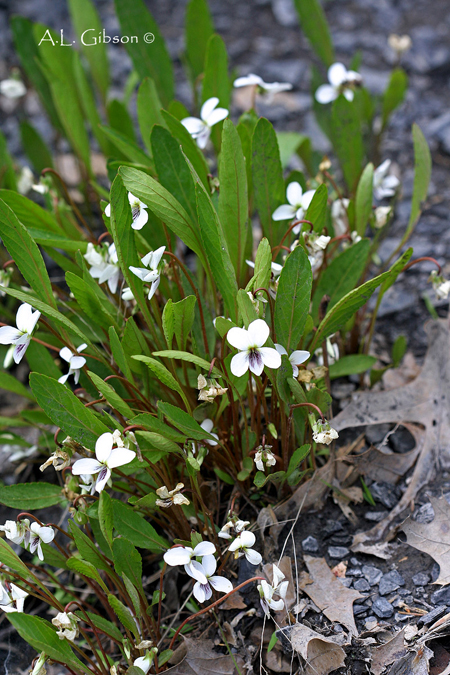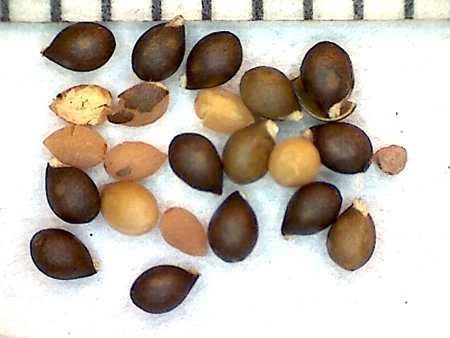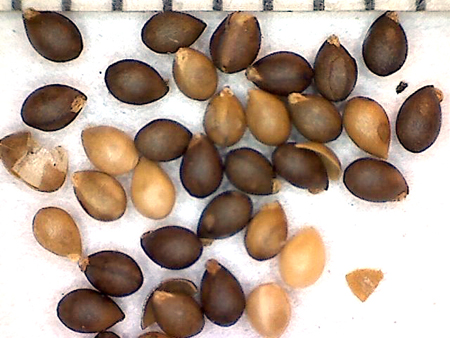Viola lanceolata L.
Common names:
Lance-leaved Violet, Northern Water Violet
Synonyms:
Viola lanceolata L., Sp. pl., ed. 1, 2: 934. 1753. TYPE: "Habitat in Canada, Sibiria" [Presumably northeastern North America, the Siberian reference an error], [no date], P. Kalm s.n. (LECTOTYPE (designated by James Reveal in Jarvis (ed.), Order out of Chaos: 924. 2007): LINN-HL1052-6). [The page for V. lanceolata in the Linnaean Names Typification Project database incorrectly states that lectotype sheet No. 1052.4 was designated as the lectotype; that sheet number is actually V. pinnata, whereas the Kalm specimen of V. lanceolata is No. 1052-6 as labeled on the sheet.]
Description:
Acaulescent stoloniferous perennials from slender rhizome, colonial from surficial stolons produced in summer, stolons leafless or leafy and infrequently with 1–few cleistogamous capsules, ≤ 30 cm tall; foliage and peduncles green, glabrous (leaf blades very rarely sparsely hirtellous in plants near the s. edge of our range); stipules free, finely glandular-fimbriate; leaves erect, leaf blades undivided, largest ≤ 140(190) × 29 mm, , 3–6(8) × as long as broad, (5)7–29 mm broad, often abruptly tapering to the petiole, narrowly elliptical to lanceolate, base narrowly to broadly cuneate, gland of marginal teeth appressed to incurved, margins appearing subentire, low-serrate or (sub)crenate, eciliate, apex obtuse to acute; chasmogamous peduncle held among or above the leaves; chasmogamous flower ≤ 13 mm; calyx glabrous, eciliate; lowest sepals narrowly triangular to ovate-triangular, acuminate; auricles short and entire, not elongating in fruit; corolla white, throat greenish-white; spur short-globose; all petals glabrous (occasionally lateral petals with sparse beard of narrowly linear to slightly clavate hairs); cleistogamous flowers produced after chasmogamous, on erect peduncle nearly or quite as long as petioles; capsule 4–12 mm, green drying light brown, unspotted or with fine red spots, glabrous; seeds 1.1–1.4 × 0.8–1.0 mm, dark olive-brown, unspotted; 2n=24.
Similar species:
This species is so distinctive that it could only be confused with a few long-leaved species in subsect. Stolonosae. It differs from Viola primulifolia in its leaf blades cuneate at base, and from Viola vittata in glabrous (rarely sparsely hirtellous) foliage, leafy summer stolons with cleistogamous capsules, proportionally shorter and broader leaf blades with an abruptly tapering leaf blade base, and ascending or incurved leaf teeth (making the margins apparently flush or shallowly crenate).
Ecology:
Acid mucky or peaty sand of bogs, pitcher plant seepage bogs, seepage slopes, swamp margins, lakeshores, depression ponds, intermittent wetlands, interdunal swales and ponds, and disturbed sites where topsoil has been scraped to the water table, such as lowland blueberry farms, sand borrowpits and sandstone quarries.
Distribution:
Widely distributed in ne. North America, NB to e. MN, south to e. SC, n. TN, s. AR and se. OK, slightly disjunct in n. NE and s. KS; absent on the Gulf Coastal Plain (reports from that region are misidentifications; no range map yet).
Rarity:
State listed in IA, OH, MN [as V. lanceolata var. lanceolata], and VT [as V. lanceolata subsp. lanceolata].
Phenology:
Chasmogamous flower March–June, chasmogamous fruit June–July, cleistogamous fruit July–November.
Affinities:
This species belongs to the Acaulescent White Violet lineage, sect. Plagiostigma Godron, subsect. Stolonosae (Kupffer.) Kupffer.
Hybrids:
Hybridizes with V. brittoniana (Forbes 1909, Brainerd 1924, Haines et al. 2011), V. incognita (Ballard 1995), V. minuscula (Brainerd 1924, Russell 1955c, Boivin 1966, Cinq-Mars 1966, Ballard 1995), and V. primulifolia (Brainerd 1924, Russell 1955c). I have observed the hybrids and, in at least those with V. minuscula and V. primulifolia, I have found the features of chasmogamous flowers and foliage to be more or less precisely intermediate. All hybrids will fail to reproduce by chasmogamous flowers. The interploidal hybrid will likely produce abortive cleistogamous capsules, while the latter two hybrids may produce abortive cleistogamous capsules or normal capsules without viable seeds or a substantially reduced proportion of viable seeds. Studies are needed to confirm these predictions.
Comments:
Brainerd (1921b), Brainerd Baird (1942), Henry (1953a), Alexander (1963), Scoggan (1978), Strausbaugh and Core (1978), and Swink and Wilhelm (1979) maintained V. lanceolata as a species distinct from V. vittata. Russell (1955c, 1965), Haines et al. (2011), and Ballard (1995, 2013) recognized the two as subspecies under V. lanceolata; while Fernald (1950), Gleason and Cronquist (1991), Ballard (2000), and Weakley et al. (2012) treated them as varieties. McKinney and Russell (2002) and Little and McKinney (2015) merged them under V. lanceolata without recognition of infraspecific taxa, while Voss and Reznicek (2012) simply recognized the present species and made no comment about V. vittata (it was outside the region of concern). Russell’s (1956c) generalized maps of regional variation in the two species (which he treated as subspecies), in which he shows an uninterrupted continuum of leaf blade length/breadth and of leaf blade length from north to south, appear to include spring and summer individuals, as summer fruiting plants of the two taxa are sharply distinct in these variables and could not have produced a continuum of variation. Reported sporadic intergradients or “transitional” plants between the two (e.g., Russell 1956c, 1965) are quite rare and are represented by plants similar to V. lanceolata in the main southeastern range of V. vittata. My examinations of a few specimens identified as transitional plants have yielded misidentifications of chasmogamous flowering plants of V. vittata that have not yet produced their extreme summer leaves. The remaining “intermediates” appear to be infrequent hybrids of V. primulifolia and V. vittata, which resemble V. lanceolata but sometimes exhibit hirtellous foliage. Additional evidence that these are distinct evolutionary species is demonstrated by the fact that the two maintain their multiple diagnostic differences and occupy distinctly different microhabitats in the narrow zone of sympatry in the Carolinas. They are most distinct, and therefore most easily and confidently identified, during summer fruit, when leaves have expanded to their fullest dimensions and plants display their typical difference in presence/absence of surficial stolons (Fernald 1949). Fernald (1950) also indicated a strong tendency toward differential height of the chasmogamous peduncles, which deserves scrutiny. A very limited sampling of seeds suggests that the two may also diverge in seed shape and dimensions, with V. lanceolata seeds being larger and narrowly obovoid to obovoid and V. vittata seeds being smaller and subglobose. Specimens from the southern end of Lake Michigan, previously identified as V. vittata Greene or V. lanceolata subsp. vittata (Greene) N. H. Russell have been examined and proven to be depauperate chasmogamous flowering V. lanceolata. De novo hybrids between the present species and V. minuscula are frequently encountered throughout their broad zone of sympatry. The hybrids are often identified as V. primulifolia, from which they are very difficult to distinguish on a macromorphological basis alone. While hybrid plants at many localities are sterile, failing to produce much viable pollen or any cleistogamous capsules or seeds, those in the western Upper Great Lakes region (namely Michigan's Upper Peninsula, Ballard 1995, and the Anoka Sand Plains of Minnesota) appear to be fertile and reproduce by abundant cleistogamous capsules and seeds. The evolutionary and taxonomic status of these fertile populations relative to Appalachian and Coastal Plain V. primulifolia requires further study.
Literature Cited:
Alexander, E. J. 1963. Violaceae. In Gleason, H. A., The new Britton and Brown illustrated flora of the northeastern United States and adjacent Canada. Hafner Publishing Co., Inc., New York, NY. 552-567.
Ballard Jr., H. E. 1995 ["1994"]. Violets of Michigan. Michigan Botanist 33: 131-199.
Ballard Jr., H. E. 2000. Violaceae. In Rhoads, A. (ed.). Flora of Pennsylvania. University of Pennsylvania Press, Philadelphia, PA. 700-710.
Ballard Jr., H. E. 2013. Violaceae. In Yatskievych, G., Flora of Missouri. Missouri Botanical Garden Press, St. Louis, MO. 1218-1243.
Boivin, J. R. B. 1966. Enumération des plantes du Canada. Le Naturaliste Canadien 93(5): 583-646.
Brainerd, E. 1921b. Violets of North America. Vermont Agricultural Experiment Station Bulletin 224: 1-172.
Brainerd, E. 1924. The natural violet hybrids of North America. Vermont Agricultural Experiment Station Bulletin 239.
Brainerd Baird, V. 1942. Wild violets of North America. University of California Press, Berkeley, CA.
Cinq-Mars, L. 1966. Mise au point sur les violettes (Viola spp.) du Québec. Naturaliste canadien 93: 895-958.
Fernald, M. L. 1949. Rhizome characters in and minor forms of Viola. Rhodora 51: 51-57, plates 1134-1136.
Fernald, M. L. 1950. Violaceae. In Gray’s Manual of Botany, 8th ed. American Book Company, New York, NY. 1022-1042.
Forbes, F. F. 1909. A new hybrid violet. Rhodora 11: 14-15.
Gleason, H. A., and A. Cronquist. 1991. Violaceae. In Manual of vascular plants of northeastern United States and adjacent Canada, 2nd ed. New York Botanical Garden, Bronx, NY. 157-163.
Haines, A., E. Farnsworth, and G. Morrison. 2011. Violaceae. In Flora Novae Angliae. Yale University Press, New Haven, CT. 873-886.
Henry, L. K. 1953a. The Violaceae in western Pennsylvania. Castanea 18(2): 37-59.
Little, R. J., and L. E. McKinney. 2015. Violaceae. In Flora of North America: Cucurbitaceae to Droseraceae, 106. Oxford University Press, New York, NY.
McKinney, L. E., and N. H. Russell. 2002. Violaceae of the southeastern United States. Castanea 67: 369-379.
Russell, N. H. 1955c. The taxonomy of the acaulescent white violets. American Midland Naturalist 54: 481-494.
Russell, N. H. 1956c. Regional variation patterns in the stemless white violets. American Midland Naturalist 56: 491-503.
Russell, N. H. 1965. Violets (Viola) of the central and eastern United States: An introductory survey. Sida 2: 1-113.
Scoggan, H. J. 1978. Violaceae. In Flora of Canada, Part 3–Dicotyledoneae (Saururaceae to Violaceae). National Museums of Canada. Ottawa, Canada. 1103-1115.
Strausbaugh, P. D., and E. L. Core. 1978. Violaceae. In Flora of West Virginia, 2nd ed. Seneca Books, Inc., Morgantown, WV. 644-658.
Swink, F., and G. Wilhelm. 1979. Violaceae. In Plants of the Chicago region, 2nd ed. revised and expanded. Morton Arboretum, Lisle, IL. 384, 801-810.
Voss, E. G., and A. A. Reznicek. 2012. Violaceae. In Field manual of Michigan flora. The University of Michigan Press, Ann Arbor, MI. 913-922.
Weakley, A. S., J. C. Ludwig, and J. F. Townsend. 2012. Violaceae. In Flora of Virginia. BRIT Press, Fort Worth, TX. 963-975.

Chasmogamous flowering habit by Arthur Haines, Native Plant Trust

Chasmogamous flowering habit by Andrew Gibson, "Buckeye Botanist" website

Chasmogamous flower front view by Arthur Haines, Native Plant Trust

Chasmogamous flower front view by Andrew Gibson, "Buckeye Botanist" website

Seeds from herbarium specimen: CT, Suffield, Field in moist, formerly tilled soil, 17 Aug 1921, C. A. Weatherby s.n. (CBS18232)

Seeds from herbarium specimen: CT, Town of Franklin, Bog across Tucker Farm, 22 Sep 1912, R. W. Woodward (CBS18215)